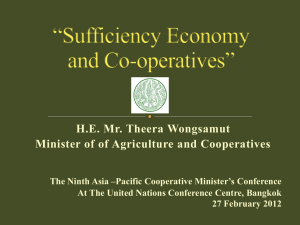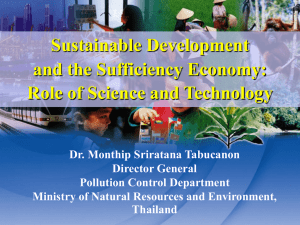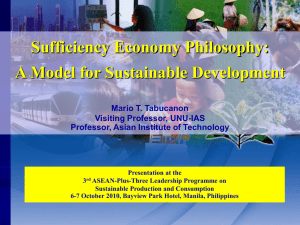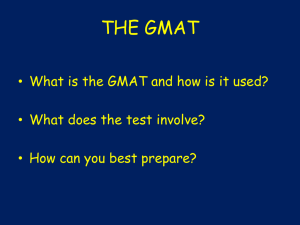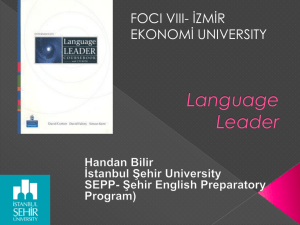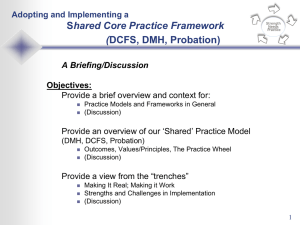Presentation of Suwanee Khamman
advertisement
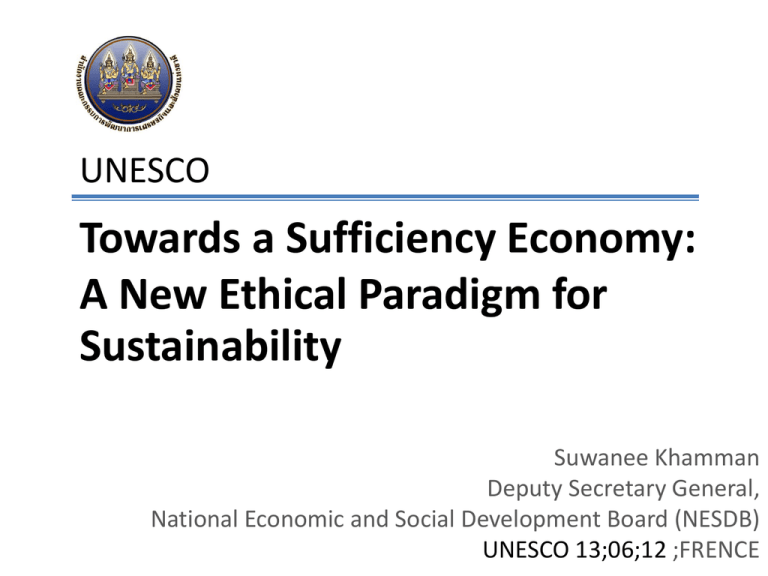
UNESCO Towards a Sufficiency Economy: A New Ethical Paradigm for Sustainability Suwanee Khamman Deputy Secretary General, National Economic and Social Development Board (NESDB) UNESCO 13;06;12 ;FRENCE Contents 1 Sufficiency Economy: A New Ethical Paradigm for Sustainability 2 Application of Sufficiency Economy 3 National Planning Process Others Partners Going Forward : Sufficiency Economy Philosophy as a Secure Foundation for Thai People 2 1 Sufficiency Economy: A New Ethical Paradigm for Sustainability 3 “…The development of the country must be fostered in stages. It must start with the construction of infrastructure, that is, the provision of food and basic necessities for the people by methods, which are economic, cautious and conforming with principles. Once the foundation is firmly established, progress can be continually, carefully and economically promoted. This approach will prevent incurring mistakes and failures, and lead to the certain and complete achievement of the objectives..” H.M. The King’s Address delivered on Kasetsart University Commencement Ceremony on 19 July 1974 4 Sufficiency Economy Philosophy • Middle Path • Moderation, Reasonableness, SelfImmunity • Knowledge, Prudence, Caution • Moral, Honesty, Perseverance, Patience, Consciousness His Majesty the King has permitted National Economic and Social Development Board to disseminate to Thai People since 21 November 1999. 5 His Majesty’s Philosophy of Sufficiency Economy aims to help people better meet the challenges arising from globalization and work towards achieving sustainable development. Within the philosophical framework, there is a choice of balanced development strategies for the nation in line with the forces of globalization, with the need for adequate protection from internal and external shocks. Therefore, the country’s economy becomes more resilient and sustainable. SEP stresses the ‘middle’ path as the overriding principle for Thai people’s conduct and way of life at the individual, family, and community levels. Sufficiency Economy Philosophy: Composition Sufficiency Economy Philosophy Goal Outcome Economy/society/environment/culture in a balanced, stable and sustainable way Immunity to materialism and social/environmental/cultural changes Lead to The Middle Path Moderate Means Reasonableness Input Knowledge Condition (Prudent and appropriate knowledge) Sufficiency SelfImmunity Integrity Condition (honesty, diligence, wisdom, sharing, perseverance) 7 THE NATIONAL ECONOMIC AND SOCIAL DEVELOPMENT PLAN (NESDP) A ROAD TO THAILAND’S DEVELOPMENT Gold Era of Planning Political Fluctuation Democracy Era Paradigm Shift Plan 1 (1961-66) Plan 2 (1967-71) Plan 3 (1972-76) Plan 4 (1977-81) crisis Plan 5 (1982-86) Economic Growth and Infrastructure Development and the Beginning of Social Development People Centred Development Paradigm Participation Approach Sufficiency Economy Plan 6 (1987-91) Economic Growth Led Development Plan 7 (1992-96) Plan 8 (1997-2001) Gcrisis Economic Stability and Social Development Plan 9 (2002-06) crisis Plan 10 (2007-2011) Community Plan Plan 11 (2012-2016 8 2 Application of Sufficiency Economy National Planning Process Other partners 9 The direction of national development towards the middle path on foundations of the dynamic equilibrium of development and readiness to cope with potential changes. Sufficiency Economy Philosophy Goal Outcome Economy/society/environment/culture in a balanced, stable and sustainable way Immunity to materialism and social/environmental/cultural changes Lead to The Middle Path Means Input Moderate Reasonableness Knowledge Condition (Prudent and appropriate knowledge) Sufficiency SelfImmunity “reasonableness” analyze country situation “moderation” decisionmaking to create a balance “self-immunity “ built into economic systems “all-round knowledge”, moving forward with circumspection “integrity”, and morality in the conduct of duty Integrity Condition “Perseverance” will build a (honesty, diligence, self-immunity system wisdom, sharing, perseverance) 10 A shift in Development Paradigm..Towards Sufficiency From Economic Development From Compartmentalization From top-down approach To people centered development -well being To integration of all dimensions To bottom-up approach Benefit to people People Popular participation A focus on people, development benefit to people, and well being a focus on “geographical conditions” that vary according to landscape and way of life in each locality “order” of development from self-reliancegrouping-networking “exploding from the inside” 11 10th NATIONAL ECONOMIC AND SOCIAL DEVELOPMENT PLAN Capital Analysis • Human Social Capital • Culture • Social Institution Moderation • Saving/Debt Economic Capital • Economic expansion Immunity • Economic Stability Reasonableness Natural Resources Capital • Forest/Soil/Water • Quality of Environment 12 11th NATIONAL ECONOMIC AND SOCIAL DEVELOPMENT PLAN Six Country’s Capital Economic Capital (EC) Social Capital (SC) (Natural Capital) (Physical Capital) (Cultural Capital) Natural Resources Capital (NC) (Social Capital) (Human Capital) (Financial Capital) 13 Imbalanced in Thai Society Regimental Imbalance Cultural Imbalance Developmental Imbalance Governmental Imbalance Source: Dr. Suvit Maesincee 14 Demographic Change in Thailand Thailand is passing the period of taking advantage from Current Situation ่ งโอกำสจำกกำรปั population In the future, populationโครงสร้ structure ไทยก ำล ังผ่ำนพ้dividend. นชว นผลทำงประชำกร ำง shows that working age will have more burden in taking ้ ในอนำคตว ัยประชำกรว ัยทำงำนจะต้องแบกร ับผูส ้ ง ู อำยุทเี่ พิม ่ มำกขึ น care of elderly. Pyramid of Thai Population Child Age(0-14 years old) tends to decrease Working Age(15-59 years old) has decreased after 2010 Old Age( 60+) continue increasing 1969 2011 2030 Child Age 45.12 20.07 13.50 Working Age 49.99 67.63 61.38 Old Age 4.89 12.26 25.12 Increasing in Dependency Ratio Increasing number of elderly that working age has to responsible for 2000 Old Age :Working Age 7:1 2011 5 :1 2030 2:1 2513 2552 2570 75+ 70-74 65-69 60-64 55-59 50-54 45-49 40-44 35-39 30-34 25-29 20-24 15-19 10-14 5-9 0-4 75+ 70-74 65-69 60-64 55-59 50-54 45-49 40-44 35-39 30-34 25-29 20-24 15-19 10-14 5-9 0-4 75+ 70-74 65-69 60-64 55-59 50-54 45-49 40-44 35-39 30-34 25-29 20-24 15-19 10-14 5-9 0-4 2513 80 70 60 50 40 30 20 10 0 Aging Population Demographic Dividend Baby Boom 2552 2570 0-14 15-59 60+ 15 Cultural Instability Culture of Minority Group Capitalism and วัฒนธรรมอเมริ กัน Politeness Materialism (Americanization) Global Culture Respect and Culture in 4 Regions Democracy,Gratutude focus on วัฒright นธรรมเกาหลี (K-Pop) and freedom Cosmo Culture National National Culture Culture Local Culture Local Culture Trust in human Enjoyment wisdom วัฒนธรรมญี ่ ปนุ่ (J-Pop) and capability Cultural flows borderless without adequate considering that lead to Islam Culture the inappropriate behaviour: Capitalism and Materialism Self-centered Carelessness in Local Culture and Wisdom 16 Global Rules & Multi Polar Environment : & Global Warming EU •UN FCCC & Post Kyoto Protocol – trend of commitment from developing countries in CO2 reduction •Increase world energy demand leads to higher GHG emission •Sectoral Approach in GHG mitigation + + - ASEAN AMERICA + - BRIC Japan Asia Africa + Trade & Services Investment Financial & IPR • Global fund for clean technology: CIF & CTF • Green outsourcing / Investment • Carbon off-shoring • CSR • Mechanisms for CO2 reduction & income generation for local community : CDM, REDD+ • Voluntary carbon market • Intellectual Property Rights can prevent technology transfer to developing countries • Tariff Barrier i.e. Border Carbon Adjustment ; IUU Fishing, • Non –Tariff Barrier to trade i.e. Technical barrier : EU energy using product, Energy label , Carbon label/footprint, ROHs & REACH for chemicals, มาตรการสุขอนามัยและสุขอนามัยพืช (SPS) ; AFTA, FTA 17 Risks Weak Public Administration Population Structure Change Natural Resources and Environmental Deterioration Vulnerable Economic Structure Deterioration Social Values Critical National Security 18 Vision of the 11th Plan Vision of the Plan (2012-2016) “A happy society with equity, fairness and resilience” Objectives : To promote a peaceful society with good governance. To promote sustainable development through restructuring the economy, society and politics, and nurturing natural resources and environment. To prepare the people and the community to be resilient to changes. 19 Developmental Areas Develop quality human and society • promoting the just society • developing human resources to promote lifelong learning society 11th Economic and Social Development Plan Good Governance and Translating Plan into Implementation 11 Economic restructuring • balancing food and energy security • creating the knowledge-based economy and enabling economic environment • strengthening economic and security cooperation in the Region Managing natural resources and environment towards sustainability conserving and restoring natural resources harnessing the production and consumption patterns towards the environmentally friendly • gearing up for the climate change 20 adaptation In order to achieve sustainable development, SEP focuses on human development, starting with the right mindset The Sufficiency approach begins and ends with people. They are the agents and the beneficiaries. That is the approach’s strength, but also its difficulty. Successful practitioners of the Sufficiency approach seem to share certain personal characteristics. They are not especially materialistic and are aware of the need for sustainable consumption. They have high respect for nature. Guideline for Promoting the Just Society strengthening the grass-root Economy, expanding the coverage of the social protection system, promoting a fair allocation of resources Generating opportunity to gain access to social services for the underprivileged group in an equitable and thorough manner creating an accepting value based on trust and mutual support Developing all citizens to have ability to participatewith dignity in social, economic and politic activities 22 Guideline for Developing Human Resources to Promote Lifelong Learning Society 2 Develop human resources aiming at increasing resilience of individual to future changes 5 Reinforcing the role of social institutions in the country development 4 Promote lifelong 3 Increasing the learning quality of the Thais at all age levels 1 Improve the quality of newborns with appropriate population distribution 23 Guideline for Economic Restructuring in the 11th NESDP Guideline for human resource development that inline with Economic Restructuring. To be a quality and sustainable economy, it requires knowledge, wisdom, science and technology, innovation, creation with the concern on friendly to environment Service Sector Development Increase competitiveness of potential businesses , broaden production bases and market, strengthen the enabling environment to induce more investment, rehabilitate deteriorating tourist attractions, strengthen capacity of parities related. Creative Economy Development Develop enabling factors in relation to the creative economy, strengthen potential of creative profession persons to apply creativity to add value in goods and services, encourage R&D for the hipotential creative products Industrial Sector Development Agricultural Sector Development Enhance the agricultural productivity and value creation with eco-friendly technology, improve soil quality and Water resource management, develop safety standards Science, Technology, Research, and Innovation Development Creating enabling environment, develop adequate infrastructure and facilities on science and technology, research, and innovation via collaboration between the government and the business circles Develop eco-industrial towns, restore the deteriorated environment in the major industrial areas, develop new hi-potential clusters, continue increase the productivity and support innovation, promote linkages of the large companies and SMEs, and relocation of industrial bases to the regions Competitiveness Development Develop financial and capital market to facilitate real sector’s restructuring, improve human capital through the better educational and retraining system, and the provision of new knowledge and know-how, revising existing laws and regulations to protect the intellectual property rights (IPR);develop infrastructures and logistics systems and Develop 24 energy security Creative Economy mechanism Supporting and enabling factors Policy Develop creative economy together with knowledge based economy Set up a clear creative economy policy and integrate in work plan of agencies related Real sector and service sector restructuring into Creative and Green Economy Develop infrastructure and internal environment particular in communication and transportation, promote investment in research and development, provide source of fund, develop education in relevant to labour market, develop market to compete with competitor and global change Value the IPR from creation, provide law and regulation to protect IPR, promote IPR to access to source of fund Develop human resources to meet the demand for creative professionals in the production and the service sectors Develop institution and integrate with agencies related in order to link as networks to support creative economy development Economic Capital (EC) Social Capital (SC) Natural Capital (NC) Natural Physical Capital Capital (NC) Cultura (PC) l Capital Social (CC) Human Capital Capital (HC) (SC) Financial Capital (FC) In depth research and development in creative economy and cultural capital issue Monitor and evaluation the implementation of creative economy continuously 25 Sufficiency Economy Application in Context of Country Development People Centered/Foundation Balanced under Dynamism Condition Moderation, Reasonableness, Self- Knowledge Immunity Individual balance between material and minds Community balance between rural-urban Economics Natural resources balance between local-global balance between utilize-conserve Good balance between governance competitive-fair deal Moral Perseverance quality human, moral and knowledge based society strong community, networks develop to link with global economy develop on strong production base natural resources base strengthened system set up and culture created in line with good governance and democracy Self reliance Adapt to changes Create immunity “Well-Being Society” 26 The direction of national development towards the middle path on foundations of the dynamic equilibrium of development and readiness to cope with potential changes. Sufficiency Economy Philosophy Goal Outcome Economy/society/environment/culture in a balanced, stable and sustainable way Immunity to materialism and social/environmental/cultural changes Lead to The Middle Path Means Input Moderate Reasonableness Knowledge Condition (Prudent and appropriate knowledge) Sufficiency SelfImmunity “reasonableness” analyze country situation “moderation” decisionmaking to create a balance “self-immunity “ built into economic systems “all-round knowledge”, moving forward with circumspection “integrity”, and morality in the conduct of duty Integrity Condition “Perseverance” will build a (honesty, diligence, self-immunity system wisdom, sharing, perseverance) 27 Various Application of Sufficiency Economy utilize resources efficiently with the concern on risk management ,human resource development, innovation, and create organizational culture (honesty, integrity, and knowledge sharing. Utilized the “New Theory” Business Sector Agriculture Sector disseminating “Best Practices” of the Press and philosophy’s application Media to inspire Thai people to apply it. Law and regulation lead to the principle Political for government to policy and Institution formulate budget with the concern on Public effectiveness , Sector reasonable cost, and response to people’s needs. Implements mega project with reasonableness and concern on risk management. Budget allocation is designed with the focus 28 on balanced investment Guide students to a better understanding Education of Sufficiency EconomyInstitution Philosophy through classroom curriculum and activities Application of Sufficiency Economy: Successful Cases Education: Princess Chulabhorn's school, Phetchaburi Headmaster has faith in Sufficiency Economy Philosophy Driving the philosophy through curriculum and all activities including way of life in the dormitory. Outcomes are expected in both educational dimension and organizational culture SMEs: Bathroom Design Co.,Ltd Integrate Sufficiency Economy Philosophy concept into the operation Accomplish business with fairness to customers, staff, society and environment Focus on human development including spirit and moral IndividualLevel: Mr.PrayongRonnarong The 2004 Ramon Magsaysay Award for Community Leadership Manage local economy by community’s members. His success is to build a rubber processing factory with community capital. Best practice or model for government and agency related to apply for poverty reduction 29 Sufficiency Economy Philosophy the means to... 1. Knowledge Based Economy 2. Ethnic Economy 3. Happiness Economy 4. Sustainable Economy 30 3 Going Forward : Sufficiency Economy Philosophy as a Secure Foundation for Thai People 31 SIX MESSAGES FOR TAKING SEP FORWARD 1 SEP : a central to alleviate poverty and reducing the economic vulnerability of the poor 2. SEP : a central to community empowerment and community strengthening to be a foundation of the national economic 3. SEP :CSR 4. SEP :improve standard of governance in public admin. 5. SEP :proved to suggest country against Shock/crisis – sustainable dev. 6. SEP thinking demands a tranformation Of value and revolution in the mindset both neccessary for the advancement of human development 32 RESEARCH AND DEVELOPMENT INSTITUTE OF SUFFICIENCY ECONOMY PHILOSOPHY FOUNDATION (RSEPF) Mission a center for collaboration and facilitation every agency to apply Sufficiency Economy Philosophy to their way of lives in various aspects. Knowledge Construction Dimensions of driving Education Driving Mechanism Sub-committee Education Standard Building Youth Youth Business Sector Business Sector Networking Local Administrative Organization Local Administrative Organisation --create activities and project with partners and implement in community -Development of Database System for Sufficiency Economy/Public Relations 33 Thank you www.nesdb.go.th 34 35 SEP can be the way of life of an organization whose own particular view of the world should be moderate, based on reason, with a through understanding of causes and effects; it will prepare of changes by creating self-immunity through practicing morality and utilizing knowledge prudently. SEP can be the way of life of an organization whose own particular view of the world should be moderate, based on reason, with a through understanding of causes and effects; it will prepare of changes by creating self-immunity through practicing morality and utilizing knowledge prudently.
